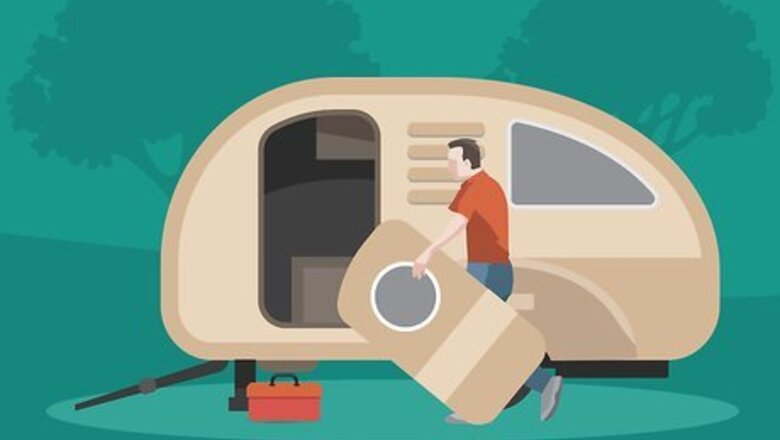
views
Cleaning and Taking Photos
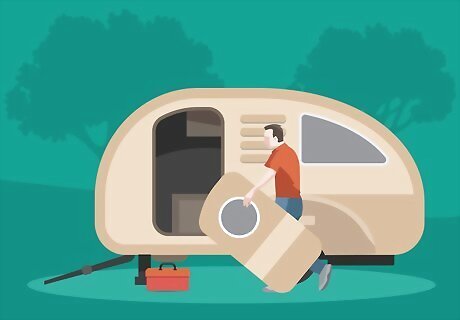
Make minor repairs to ensure that your trailer will sell. Buyers aren’t going to be interested in purchasing a trailer at your desired price if they need to make a bunch of repairs. Fix any flat tires, replace rusted bolts and nuts, and get broken windows repaired. Make any minor repairs that you can without spending more money than what your trailer is worth.Tip: Skip repairs that will cost more than the price your trailer will fetch from a buyer. If you need to make major repairs and it won’t be worth your time, consider selling your trailer to a metal recycler or scrap dealer for $50-100 dollars. If you’re selling a camper, replace dead lightbulbs and consider replacing the microwave, bedding, or upholstery as needed.
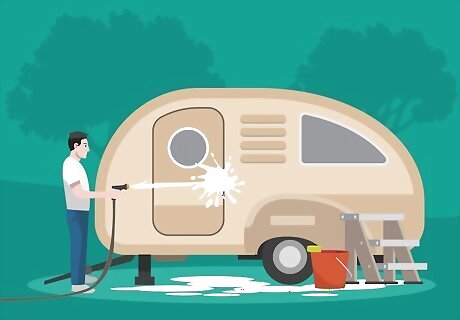
Wash the exterior of your trailer with vehicle soap and water. Wash the exterior of your trailer using a vehicle soap and a hose. Wipe your windows down and use a squeegee and water to remove any streaks or dead bugs. Polish the wheels to make them shine like new. If you have a larger trailer, you can use a low-power pressure washer. Just make sure that you don’t aim the water directly at the windows or any sensitive areas of the trailer.

Clean the interior of your camper or RV to entice potential buyers. If you’re selling a camper, clean the interior like it’s a room in your home. Vacuum any carpeting and use disinfectant wipes to clean down the seats, furniture, and any other surfaces inside. If you have a large RV, consider hiring a professional cleaning company to do this for you. You’ll save a ton of time and it won’t cost very much considering how much you’re probably going to make in return.
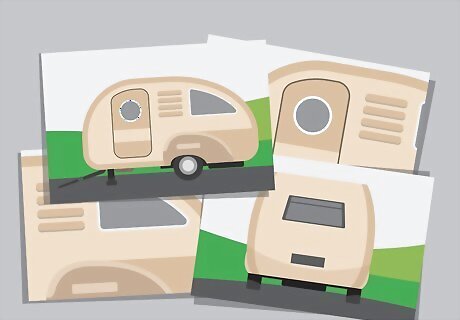
Take 5-6 photos of the exterior of the trailer from a variety of angles. Set your trailer up in your yard. When the sun is out during the day, use a high-quality camera to take photos of your trailer. Take 5-6 photos from different angles around the trailer to give buyers a good idea of what the trailer looks like. If you’re selling a commercial trailer, take photos of the bed of the trailer and the hitch where it connects to a truck. If you take a photo of your trailer while it is attached to your vehicle, cover your license plate with a sheet of paper or blur the letters and numbers out using an editing program.

Get 6-10 photos of the interior if you’re selling a camper or RV. For a camper or RV, take an additional set of photos of the interior to give buyers a sense for what it looks like inside. Take photos of the bathroom, if there is one, and any key components, like sinks, cabinets, lights, and seating. A camper or RV buyer is generally going to be more interested in the inside than the outside, so take a large number of photos of the inside. If you’re selling a utility trailer or commercial platform trailer, there is obviously no interior to photograph. Feel free to skip this step.
Pricing Your Trailer and Writing an Ad
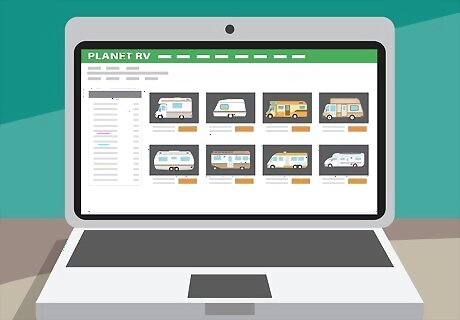
Research your price based on comparable trailers being sold online. Go on eBay, Craigslist, and trailer-selling websites. Scroll through results and look for posts that look similar to your trailer. If you know the make and model of your camper or RV, search specifically for your type of trailer. Compile a list of prices based on similar models to give you a sense for what your trailer may be worth on the market.Tip: Generally speaking, the bigger and newer your trailer is, the more expensive it should be. Utility trailers often cost $200-1,500. Campers often cost $10,000-50,000 depending on the features. Commercial trailers can cost $3,000-75,000 based on the design and what they’re capable of hauling. Trailer trader (https://www.trailertrader.com/sell-your-trailers) and Buy My Trailer (https://www.buymytrailer.com/) are 2 of the most popular websites for buying and selling trailers privately. They’re basically like Craigslist for trailers, and you can sell any type of trailer on these sites.

Set your price based on research and the quality of your trailer. Once you have a sense for what your type of trailer is worth, consider how your specific model may impact its value. If the trailer is pretty beat up and the paint is rusted out, drop the price to 60-75% of the value you found online. If you’ve never used the trailer, consider setting the price at more than 95% of what you bought it for. If a brand-new version of your trailer sells for $10,000 and you’ve only used the trailer 3-5 times, you may be able to fetch $8,000 for it. If your trailer has dents and is heavily used though, you may only get $2,500 for it. It all depends on the market and the demand for trailers where you live. If you want the best price available, test the market by listing your trailer for more than you think it’s probably worth to see if you get offers. This is the best way to fetch a high price, since potential buyers will talk you down.

Write your advertisement by listing the make, model, and function. Start your ad by listing your make and model if you know it. If you don’t, inspect your trailer for a company name and search online to find your specific model. Then, describe what you’ve been using the trailer for. For example, you may start, “I am selling a 2010 John Deere utility trailer. I purchased it in 2012 and have used it 2-3 times a month for 8 years to transport farming tools.” it’s not the end of the world if you can’t find the name of your specific model. It does help buyers look up details about the trailer online, though.
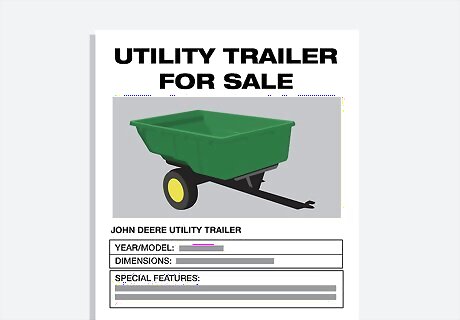
Include the year, dimensions, and other key features of the trailer. Include the year you bought the trailer and an estimate of how many miles the trailer has traveled. Finally, include the dimensions, condition, and a general description of the trailer’s features so that potential buyers can determine whether it will suit their needs. Include your price at the bottom of your advertisement. If you have an equipment trailer, list the type of equipment that the trailer is designed to haul. If you have a livestock trailer, list whether you used it to transport horses, pigs, chickens, or some other animal. For example, you may write, “I’ve never had any issues with the trailer, and it features a simple hitch setup that makes attaching it to your vehicle easy. It is 5 by 8 ft (1.5 by 2.4 m) and can be used to transport a variety of materials.”
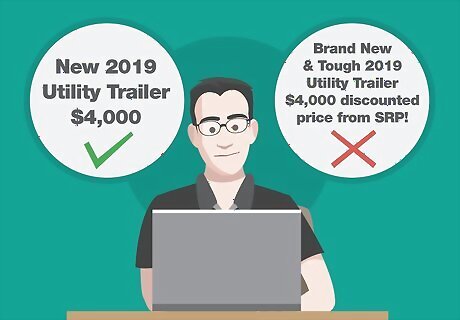
Compose a headline that contains the key information. For your headline, give a general overview of the trailer’s dimensions, price, and condition. Avoid verbose or needlessly elaborate titles to get right to the essential information. For example, “New 2019 Utility Trailer - $4,000” is a succinct headline. Exaggerating or using clickbait in your title can make your advertisement sound like a scam. It’s better to stick with straightforward facts that the buyer will be interested in.
Finding a Buyer

Put a “For Sale” sign and your phone number on your trailer to sell it locally. To sell your trailer locally, park your trailer in your driveway or front lawn. Put a “For Sale” sign on your trailer and list your phone number. You can list a few other details if you’d like, including the price and whether it is negotiable, but it’s not mandatory. Wait for people in your area to contact you to sell the trailer locally. Selling your trailer locally is a good idea if you live in an area where trailers are common and want to sell directly to someone in your area. It may not be a good choice if you live in an urban area where trailers are less common.
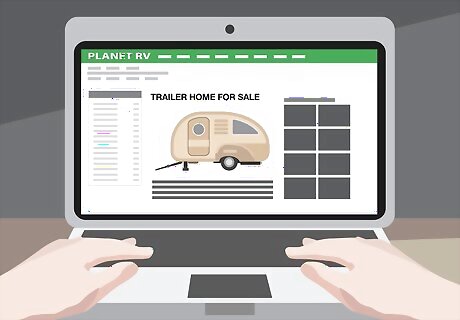
List your trailer for sale online to get the most money. List your advertisement on Craigslist, eBay, and any social media groups designed for selling trailers. At the same time, list your advertisement on special trailer buying sites to access as many potential buyers as possible. Include as many photos as each site allows and check your email and messages frequently to ensure that you reply to buyers as they respond to your ad. You will likely get the most amount of money by posting your trailer for sale online because more people are going to see the advertisement, which will give you more opportunity to turn offers down and negotiate. Selling a trailer online will generally take a while, though. TrailerTrader and Buy My Trailer are the most frequently trafficked websites for companies and individuals looking to buy trailers.
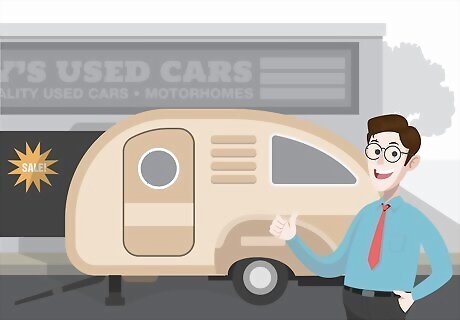
Sell your trailer to a dealership to get rid of it quickly. Most trailer dealerships will purchase used trailers for resale. Look online to find trailer dealers near you and call them. Get quotes and compare the offers to find the best price possible. Once you find a price that sounds fair, take your trailer to the dealer to sell it in person. You are unlikely to get as much for your trailer as you would if you sell it privately, but you won’t need to wait to get rid of your trailer. You can still negotiate with dealerships, but you still won’t make as much as you would selling the trailer online.
Meeting with Buyers and Transferring the Title
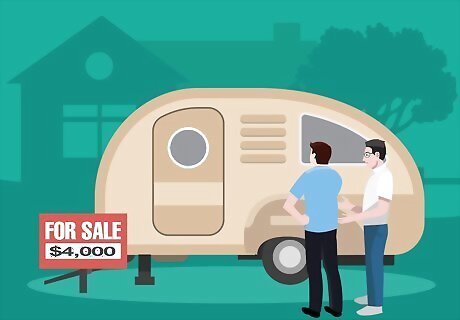
Meet with potential buyers to let them inspect the trailer. As buyers contact you, set up meeting times to show them your trailer. Give them some space as they inspect the trailer and don’t get pushy when it comes to closing the deal. Answer any of their questions honestly. Show them how the trailer hooks up to your vehicle and any other specific features that are unique to your trailer. If you’re selling your trailer to a dealer, you’ll need to take your trailer to them to have it appraised and inspected. Share copies or receipts of any repairs that have been made on the trailer. Not only is it the right thing to do, but lying to a buyer about repairs is often illegal.
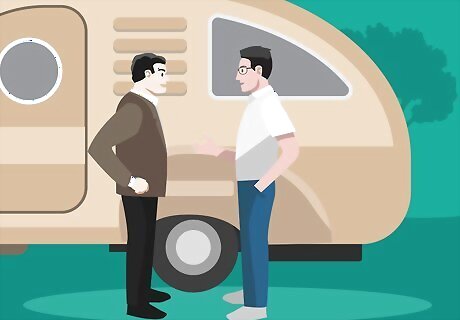
Negotiate your price with potential buyers before selling the trailer. Once you get an offer from a buyer or dealership, negotiate your price as desired. If you’re happy to simply accept their initial offer, feel free to take it. Otherwise, use the tractor’s best qualities to justify a higher price. Point out your trailer’s condition, utility, or consistent performance and haggle over your pricing.Tip: If a buyer offers to purchase your trailer for the listed price, do not try to gouge them by asking for more money. Not only is this an unfair thing to do, but it may also turn the buyer away from buying from you. For example, if your price is set at $500 and the buyer offers $300, you may say, “Well, this trailer is less than 2 years old and I’ve replaced all of the tires. It’s easily worth more than that. Would you consider $450?”
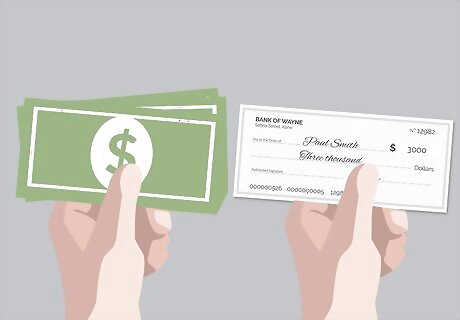
Agree on a form of payment and avoid scams. Once you and your buyer agree on a price, take their payment. Generally speaking, cash is the best form of payment, but you can take a check as well. Make sure that the check clears before transferring the title. If a buyer wants offers some kind of payment plan, money transfer, or other odd form of exchange, it may be a scam. You can take a cashier’s check or company check, but make sure that the cash is in your account and the check has cleared before handing your trailer over.

Write up a bill of sale to create proof of the transaction. Once you and your buyer agree on a price, pick up or download a bill of sale form from your local DMV. Include your address, name, and have the buyer fill their information out on the paper. List the purchase price exactly as you sold it. You are going to pay taxes on the sale, and lying about the purchase price is usually illegal. In most regions, trailers are sold and transferred the exact same way that standard vehicles are. The names of the forms you need may be a little different, though.
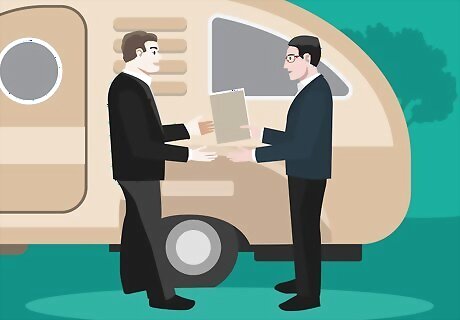
Transfer the trailer’s title to its new owner to complete the transaction. Go to the DMV with your trailer’s title. Transfer your title at the DMV and sign the title over to the buyer. This process may be different depending on where you live. With the title transferred, have the buyer sign it to complete your transaction. In some regions, you can pay the taxes on the sale at the DMV when you sign the title over. You may be able to complete all of these forms at the dealer if you sell to a business.













Comments
0 comment